|
|
|
Sort Order |
|
|
|
Items / Page
|
|
|
|
|
|
|
| Srl | Item |
| 1 |
ID:
136340


|
|
|
|
|
| Summary/Abstract |
“Salafi”, also known as salafiyya, is derived from the Arabic, meaning“the venerable predecessors”, who are the“first three generations of Islam”. In the different interpretations of the Arabic scriptures,“Salafi” evolved gradually into“Doctrinal, Political and Jihad Salafi”.“Jihadist Salafi”, also known as“Salafi Jihadism”or the“Salafi Global Jihad Movement”, by means of falsification of the religious terms in the Koran and Hadith, bewitched its followers with a message of martyrdom for Islam through violence and“Jihad”, eliminated all the heretics, established Islamic political power and restored“true Islam”religiously. Since 2011, a series of terrorist attacks carried out by“Jihadist Salafi”, represented by Jund al-Khilafah in Central Asia, have posed serious threats to regional security. This not only impacts on the anti-extremism policies and anti-extremism policies of Central Asian countries and severely challenges the SCO and CIS, but also poses a significant threat to the security of China’s Northwest.
|
|
|
|
|
|
|
|
|
|
|
|
|
|
|
|
| 2 |
ID:
135091


|
|
|
|
|
| Summary/Abstract |
The author uses the latest theoretical and conceptual approaches to world politics and international security to analyze the Afghan problem. He suggests that certain commonly accepted ideas about the strategic situation in Afghanistan should be reviewed to arrive at more exact interpretations of the “traditional” and “non-traditional” threats and other concepts. He also formulates a concept of systemic securitization for Afghanistan’s future.
|
|
|
|
|
|
|
|
|
|
|
|
|
|
|
|
| 3 |
ID:
134767


|
|
|
|
|
| Summary/Abstract |
As a research institute based in Singapore, the EAI monitors developments in relations and interactions between China and the individual countries of Southeast Asia as well as the ASEAN grouping as a whole. This material is presented in the form of (1) a chronology of events and (2) important documents.
|
|
|
|
|
|
|
|
|
|
|
|
|
|
|
|
| 4 |
ID:
136644


|
|
|
|
|
| Summary/Abstract |
China's military developments and growing naval capabilities are the focus of much discussion among strategists and policy makers. China's moves in this direction are of particular concern because of the implications to maritime security in the region, particularly to countries that have territorial disputes. Its burgeoning military power and growing naval and maritime capability are linked to the country's overall maritime strategy and rising profile in the international arena, raising questions outside the region as to her long-term intentions in the Asia-Pacific region. Of particular interest is China's Anti-access Area-denial (A2/AD) strategy. This paper undertakes an analysis of China's military with specific reference to the A2/AD strategy, and is premised on the belief that the A2/AD strategy is a component of overall Chinese maritime strategy. This paper suggests that People's Liberation Army Navy military capabilities and force developments are inter-related to the evolution of China's maritime strategy, and that China's building onto A2/AD would pose a significant threat to regional security.
|
|
|
|
|
|
|
|
|
|
|
|
|
|
|
|
| 5 |
ID:
136011
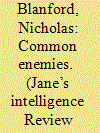

|
|
|
|
|
| Summary/Abstract |
Amid the ongoing regional security threat, Hizbullah and the US now have a shared enemy in the Islamic State. Nicholas Blanford examines Lebanon’s ambivalent attitudes towards the anti-Islamic state coalition and explores the potential for co-operation.
|
|
|
|
|
|
|
|
|
|
|
|
|
|
|
|
| 6 |
ID:
135934


|
|
|
|
|
| Summary/Abstract |
The EU calls itself a “soft power,” making “soft power” contributions to Asian security. That is undoubtedly what the EU is and does in Asia and the track record of European contributions to Asian peace and stability through economic and financial as well as development aid and technical assistance over the decades is not unimpressive. As will be shown below, over recent years Brussels and the Union's individual member states have sought to increase their involvement and role in Asian “hard security,” attempting to get rid of its reputation of being security a “free-rider” enjoying but not sharing the burden of US regional security guarantees. While the EU will continue to be a “hard security” actor in Asian security within limits, it is advised to concentrate its security cooperation with like-minded partners such as Japan and the US as opposed to hoping that talking to Beijing on regional or global security issues produces tangible results. As will be shown below, it clearly does not as Beijing continues to conduct very assertive and at times aggressive regional foreign and security policies insisting on the “principle of non-interference” in Chinese domestic and foreign policies. Consequently, EU influence on Chinese foreign and security policies in general and its increasingly aggressive policies related to territorial claims in the East China and South China Seas will continue to exist on paper and paper only.
|
|
|
|
|
|
|
|
|
|
|
|
|
|
|
|
| 7 |
ID:
136655


|
|
|
|
|
| Summary/Abstract |
Nepal shares an open border of 1,868 km with five Indian states (Uttarakhand, Uttar Pradesh, Bihar, West Bengal and Sikkim) and 1,415 km with Tibet. Under the 1950 Treaty of Peace and Friendship with India, Nepali citizens enjoy ‘national’ treatment and Nepali businesses unhindered rights of trade, transit and movement. An estimated six million Nepalese live and work in India and contribute to their inward remittances. Social intercourse along the Gangetic plane is described by people as ‘roti-beti ka sambandh’ (a RELATIONSHIP based on sharing of hearth and marriage). Predominantly a land of believers of Hinduism and Buddhism, Nepal shares a long and enduring cultural history with India. The Hindus of India hold Pashupatinath in high esteem and those of Nepal the Char Dham of India (the four important abodes of the Hindu pantheon in India, namely Jagannath Puri, Dwarka, Rameswaram and Badrinath). Lumbini and Bodhgaya join the common ethos of Buddha’s life and teachings. About 40,000 Gurkha soldiers serve in the Indian army today.
|
|
|
|
|
|
|
|
|
|
|
|
|
|
|
|
| 8 |
ID:
136415


|
|
|
|
|
| Summary/Abstract |
The author analyzes the dynamics of Russian-American relations in the Greater Caucasus throughout the twenty-odd post-Soviet years, reveals the main development trends, and assesses the degree of confrontation and possibility of cooperation on the key regional issues in the context of the latest developments.
|
|
|
|
|
|
|
|
|
|
|
|
|
|
|
|
| 9 |
ID:
136633
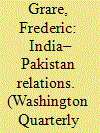

|
|
|
|
|
| Summary/Abstract |
As the new Indian government has settled in, what will happen to its relations with Pakistan? While some take comfort in the idea that the strong nationalist credentials of the new Prime Minister could facilitate a peace agreement with Pakistan, others argue that the risk of communal violence created by the Hindutva ideology1 of the new government could be a potential impediment to better India–Pakistan relations. But the evolution of the bilateral relationship is unlikely to depend on either of these considerations; it is also unlikely to depend primarily on New Delhi.
Narendra Modi's decision to invite his Pakistani counterpart, Nawaz Sharif, to his May 26, 2014, swearing-in ceremony, along with all the other heads of state or government from the South Asian Association for Regional Cooperation (SAARC), was considered a positive gesture on both sides of the border. The meeting between the two Prime Ministers was cordial and frank but—to no one's surprise—not groundbreaking. However, the two countries have already interpreted this early meeting differently.
|
|
|
|
|
|
|
|
|
|
|
|
|
|
|
|
| 10 |
ID:
136862
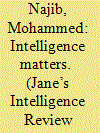

|
|
|
|
|
| Summary/Abstract |
Intelligence sharing and cooperation between Arab countries are key to tackling the Islamic State threat in the region. Mohammed Najib assesses relations between regional security agencies and the role of intelligence operations in undermining the group.
|
|
|
|
|
|
|
|
|
|
|
|
|
|
|
|
| 11 |
ID:
136205
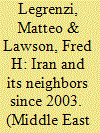

|
|
|
|
|
| Summary/Abstract |
Iranian foreign policy in the 25 years after the 1978-79 revolution centered on the cultivation of strategic alignments with a wide range of radical states and revolutionary movements throughout the Middle East. Relations with this heterogeneous collection of regional partners, particularly those with Syria and the Lebanese Shii organization Party of God (iezbollah), left the Islamic Republic vulnerable to periodic threats of entrap¬ment and abandonment by its allies. This in turn had a direct impact on Iran's relations with regional adversaries
|
|
|
|
|
|
|
|
|
|
|
|
|
|
|
|
| 12 |
ID:
135970
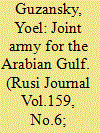

|
|
|
|
|
| Summary/Abstract |
Ongoing rivalries between members of the Gulf Cooperation Council make it an ineffective player in the region’s security When allies face serious external threats, their disagreements are often sidelined in order to promote a more visibly united front. Indeed, internal and external challenges recently prompted the six Arab monarchies of Saudi Arabia, the United Arab Emirates, Qatar, Kuwait, Oman and Bahrain to announce the formation of a joint military command. However, Yoel Guzansky argues that, as past experience indicates, this initiative might remain hostage to intra-Gulf Cooperation Council rivalries and make only a marginal contribution to Gulf security.
|
|
|
|
|
|
|
|
|
|
|
|
|
|
|
|
| 13 |
ID:
136646


|
|
|
|
|
| Summary/Abstract |
The global order is undergoing a churn and the general pointers forecast an era of a cataclysmic systemic change. The pronouncement of the “Rebalance to the Asia-Pacific”, indicating a shift in US strategic focus to Asia, has captured the imagination of the scholars and the analyst community alike. Within the prevailing nebulous and uncertain global architecture, this strategic recast by the dominant security provider has far-reaching implications. Considering the contextual underpinnings of various policy articulations and the geographic construct of this strategic reorientation, the maritime element would play a crucial role in this re-alignment of US strategic posture. This paper aims to deconstruct the maritime–military context of the US rebalance and draw out necessary implications for international, regional and Indian strategic calculus.
|
|
|
|
|
|
|
|
|
|
|
|
|
|
|
|
| 14 |
ID:
135064


|
|
|
|
|
| Summary/Abstract |
This article draws on literature, media reports official Mongolian press releases and statements and a number of informal interviews and discussions with Mongolian policymakers and politicians.
Mongolia’s unique relationship with and access to the DPRK’s leadership has primarily proven to be a most valuable asset in boosting Mongolia’s profile in the region and the world at large. Whether Mongolia can spearhead a regional security mechanism, as suggested by both Mongolian politician and international analysts remain to be seen.
|
|
|
|
|
|
|
|
|
|
|
|
|
|
|
|
| 15 |
ID:
136327


|
|
|
|
|
| Summary/Abstract |
Our planet is witnessing the onset of a new stage in globalization, multipolarity and IT application. As a result of this, a fresh reshuffle is underway, coupled with the shifting sands of geo-politics and geo-economics. This has led to major challenges in the established international system and world order.1 The same is also true for the regional picture. Indeed, the turmoil in Ukraine, the unrelenting crisis in the Middle East, and the vortex in the Asia-Pacific, have led to unusual activity in the three blocks of Europe, the Middle East and the Pacific. Under the disguise of an apparent absence of interconnectivity, in-depth interactions are actually at work between them on the question of the future peace and stability of the international community as a whole.
|
|
|
|
|
|
|
|
|
|
|
|
|
|
|
|
| 16 |
ID:
135331


|
|
|
|
|
| Summary/Abstract |
In the post–Cold War period, scholars have considered the Asia Pacific to be ripe for military competition and conflict. Developments over the past decade have deepened these expectations. Across the region, rising military spending and efforts of various states to bolster their military capabilities appear to have created an increasingly volatile climate, along with potentially vicious cycles of mutual arming and rearming. In this context, claims that China's rapid economic growth and surging military spending are fomenting destabilizing arms races and security dilemmas are widespread. Such claims make for catchy headlines, yet they are rarely subject to rigorous empirical tests. Whether patterns of military competition in the Asia Pacific are in fact attributable to a security dilemma–based logic has important implications for international relations theory and foreign policy. The answer has direct consequences for how leaders can maximize the likelihood that peace and stability will prevail in this economically and strategically vital region. A systematic empirical test derived from influential theoretical scholarship on the security dilemma concept assesses the drivers of bilateral and multilateral frictions and military competition under way in the Asia Pacific. Security dilemma–driven competition appears to be an important contributor, yet the outcome is not structurally determined. Although this military competition could grow significantly in the near future, there are a number of available measures that could help to ameliorate or manage some of its worst aspects.
|
|
|
|
|
|
|
|
|
|
|
|
|
|
|
|
| 17 |
ID:
135273


|
|
|
|
|
| Summary/Abstract |
Despite a tense security situation, the uncertainties related to withdrawal of the International Security Assistance Force (ISAF), and the increased activities of its competitors (Pakistan and China), India has not substantially stepped up its security governance engagement in Afghanistan. In this article, I explain India's hesitant policy as a factor of domestic-level threat assessments, international pressures, and the risk-averse character of Indian foreign policy.
|
|
|
|
|
|
|
|
|
|
|
|
|
|
|
|
| 18 |
ID:
136645


|
|
|
|
|
| Summary/Abstract |
As the center of world economic growth and world politics is shifting to East Asia, the region is undergoing a strategic transformation due to the ongoing power shift. As a result, major regional powers, namely the USA, China, Japan, India, South Korea, Australia and South East Asian states are building up their military potential, in particular naval forces, amid aggravating regional security problems and escalation of maritime disputes. This paper aims to assess regional strategies and military buildup in the Indo-Pacific. With the USA seeking to preserve dominance in the region, China trying to realign the regional power dynamics in its favor, Japan aiming to preserve its place as one of the regional leaders, India and Russia with their goals to become independent powers, and middle and small powers searching for an adequate answer to regional challenges, East Asia and the Indo-Pacific are clearly showing a complex dynamics of competing regional strategies and visions of regional order.
|
|
|
|
|
|
|
|
|
|
|
|
|
|
|
|
| 19 |
ID:
136650


|
|
|
|
|
| Summary/Abstract |
This article aims to delve into the patterns of convergence and divergence of interests among three key regional players in the Middle East: the Russian Federation, Turkey and Iran. Reflecting on three recent pivotal events—namely the Syrian question and growing extremism in the Middle East; the Iranian quest for normalisation of ties with the West; and the annexation of Crimea by Russia and ongoing Black Sea disputes—the article argues that Moscow, Ankara and Tehran are seen as attempting, at least in the short term, to narrow down their foremost geopolitical differences for the sake of preserving their national interests as well as regional security and stability.
|
|
|
|
|
|
|
|
|
|
|
|
|
|
|
|
| 20 |
ID:
136578


|
|
|
|
|
| Summary/Abstract |
In view of the changing security environment in Northeast Asia, stemming from China’s assertiveness in regional issues and North Korea’s nuclear weapons program, the threat perception in Japan has considerably heightened. This has triggered a debate domestically in Japan about whether it is an appropriate time to review its nuclear option as a means of deterrence. Such thinking presupposes that confidence
in the U.S. extended deterrence has started eroding or has weakened. There are various political strands to this issue and there is no consensus yet reached to make
the change officially possible. If Japan does indeed initiate a change in policy seriously, it would make the United States uncomfortable. But given the strong anti-nuclear sentiment in Japan, it would be difficult for any government of any party to sell the idea to the people. The domino effect of such a policy change would be seen almost immediately in South Korea and Taiwan, making Northeast Asia the world’s most nuclearized region. This would also mean the abrogation of the security alliance relationship with the United States. Given Japan’s capability in terms of capital, technology and possession of sufficient spent fuel needed for making the nuclear bomb it would be possible for Japan to make a nuclear bomb, but it would be a politically dangerous move and therefore inadvisable. Though it would remain theoretically possible, the debate would remain as an academic exercise for quite some time. This essay makes an attempt to study this complex issue as objectively as possible.
|
|
|
|
|
|
|
|
|
|
|
|
|
|
|
|
|
|
|
|
|